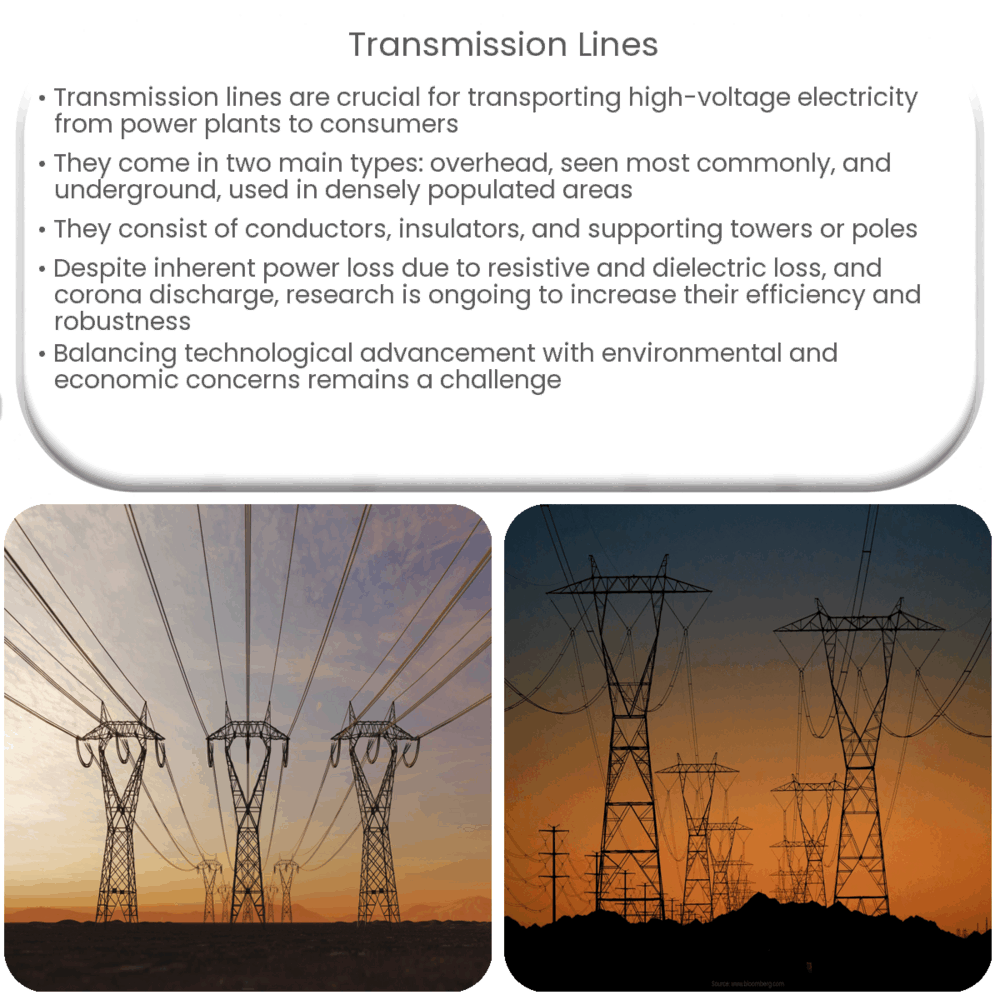Explore the fundamentals of transmission lines, their structure, types, and the physics behind their operation. Delve into the challenges and future of power transmission.

Introduction to Transmission Lines
Transmission lines are a critical component in the distribution and delivery of electric power. They carry high-voltage electricity over long distances from power plants to consumers in homes and businesses. Their intricate structure and design ensure the safe and efficient transport of electricity.
Types of Transmission Lines
Transmission lines can be broadly classified into two main types:
- Overhead Transmission Lines: These are the most commonly seen type of transmission lines, strung high above the ground on tall towers. They are designed to carry large amounts of electricity over long distances.
- Underground Transmission Lines: These lines are installed underground. Though less common due to their high installation and maintenance costs, they are often used in densely populated areas where overhead lines are not feasible.
Structure of Transmission Lines
Transmission lines comprise three main components:
- Conductors: These are the physical lines, often made of aluminum or copper, that carry the electrical current.
- Insulators: These prevent the current from flowing into the towers, poles, or the ground, maintaining safety and efficiency.
- Towers or Poles: These structures support the conductors, raising them high off the ground to prevent accidents and ensure the smooth flow of electricity.
Physics Behind Transmission Lines
Transmission lines operate on the principles of electromagnetic fields and wave propagation. They can be modeled as a distributed element network of resistors (R), inductors (L), capacitors (C), and conductors (G). These elements represent the line resistance, inductive reactance, capacitive susceptance, and conductance, respectively. The interaction of these components is usually analyzed using complex numbers and phasor diagrams, making transmission line theory a fascinating subfield of electrical engineering.
For the effective transmission of power, it is critical that the ‘impedance’ of the transmission line matches that of the load (consumer device or electrical grid). Impedance mismatch can lead to ‘reflections’, causing power loss and inefficiencies. Hence, power engineers must carefully design and manage transmission lines to ensure maximum power transfer and minimum loss.
Losses in Transmission Lines
Even with optimal design and construction, some power loss is inevitable in transmission lines. The primary causes of these losses are:
- Resistive Loss: Due to the resistance of the conductor material, some power is lost as heat. Aluminum and copper, common conductor materials, are chosen for their low resistivity, but they still contribute to power loss.
- Dielectric Loss: Insulators have a property called dielectric constant, which determines their ability to store electrical energy. Some of this energy can be lost as heat, particularly when using materials with high dielectric constants.
- Corona Discharge: Under high voltage, the air around conductors can ionize, creating a luminous discharge called a corona. While visually striking, coronas cause power loss and generate noise and electromagnetic interference.
Future Developments and Challenges
As we increasingly rely on electrical power for daily life, the demand for efficient and robust transmission lines is growing. This has spurred research into materials with lower resistivity and higher heat tolerance, and the development of techniques to reduce losses, such as high-voltage direct current (HVDC) transmission.
However, the expansion and modernization of transmission lines face numerous challenges, including environmental concerns, community opposition to new overhead lines, and high costs. Engineers and policymakers must strike a balance between technological, economic, and environmental factors as they shape the future of power transmission.
Conclusion
In conclusion, transmission lines are a fundamental part of our electricity distribution system, conveying power from generation plants to end users. While the physics of transmission lines may seem complex, their principle is based on well-understood electrical and electromagnetic phenomena. Despite the challenges of power loss and modernization, ongoing technological advancements promise to improve the efficiency and sustainability of our power transmission infrastructure, enabling a more electrified and energy-efficient future.

